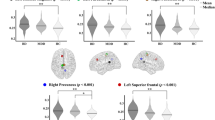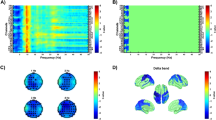Abstract
Electroencephalography (EEG) has been widely used in the neurophysiological investigation of major depressive disorder (MDD) during past decades. An approach that has attracted particular interest over the past 20 years is current source density (CSD) that assesses current source in extracellular spaces, which are the local generators of the field potentials caused by the activation of neurones. Our aim was to review the current literature regarding resting state CSD analysis in MDD patients. To date, the most prominent aspects in such studies comprise the identification of clinical endophenotypes on the basis of resting state CSD, and the investigation of CSD with respect to treatment outcome prediction. Increased alpha band resting state CSD in frontal regions is typical for MDD, while increased theta band activity in the rostral anterior cingulate gyrus (rACC) has been found to be a good predictor of better antidepressant response. However, differences in the methods used in different studies could be responsible for some contradictions in reported findings. Further research is needed for better distinction of depressive patients from patients with other psychiatric disorders, as well as from healthy subjects.

Similar content being viewed by others
References
Alexopoulos GS, Kiosses DN, Choi SJ, Murphy CF, Lim KO (2002) Frontal white matter microstructure and treatment response of late-life depression: a preliminary study. Am J Psychiatry 159:1929–1932
Alschuler DM, Tenke CE, Bruder GE, Kayser J (2014) Identifying electrode bridging from electrical distance distributions: a survey of publicly-available EEG data using a new method. Clin Neurophysiol 125:484–490
Arns M, Gunkelman J, Olbrich S, Sander C, Hegerl U (2011) EEG vigilance and phenotypes in neuropsychiatry: implications for intervention neuromodulation and neurofeedback. In: Coben R, Evans JR (eds) Neurofeedback and neuromodulation. Techniques and applications, 1st edn. Elsevier, London, Burlington, San Diego, pp 79–123
Bajbouj M et al (2010) Two-year outcome of vagus nerve stimulation in treatment-resistant depression. J Clin Psychopharmacol 30:273–281
Begic D, Popovic-Knapic V, Grubisin J, Kosanovic-Rajacic B, Filipcic I, Telarovic I, Jakovljevic M (2011) Quantitative electroencephalography in schizophrenia and depression. Psychiatr Danub 23:355–362
Boggio PS, Rigonatti SP, Ribeiro RB, Myczkowski ML, Nitsche MA, Pascual-Leone A, Fregni F (2008) A randomized, double-blind clinical trial on the efficacy of cortical direct current stimulation for the treatment of major depression. Int J Neuropsychopharmacol 11:249–254
Bruder GE, Sedoruk JP, Stewart JW, McGrath PJ, Quitkin FM, Tenke CE (2008) Electroencephalographic alpha measures predict therapeutic response to a selective serotonin reuptake inhibitor antidepressant: pre-and post-treatment findings. Biol Psychiatry 63:1171–1177
Bruder GE et al (2012) Relationship of resting EEG with anatomical MRI measures in individuals at high and low risk for depression. Hum Brain Mapp 33:1325–1333
Burton PR et al (2007) Genome-wide association study of 14,000 cases of seven common diseases and 3000 shared controls. Nature 447:661–678
Davidson R, Chapman J, Chapman L (1987) Task-dependent EEG asymmetry discriminates between depressed and nondepressed subjects. In: Psychophysiology. Soc Psychophysiol Res 1010 Vermont AVE Nw Suite 1100, Washington, 20005, pp 585–585
Debener S et al (2000) Is resting anterior EEG alpha asymmetry a trait marker for depression? Neuropsychobiology 41:31–37
Essau CA, Lewinsohn PM, Seeley JR, Sasagawa S (2010) Gender differences in the developmental course of depression. J Affect Disord 127:185–190
Etkin A, Egner T, Kalisch R (2011) Emotional processing in anterior cingulate and medial prefrontal cortex. Trends Cognitive Sci 15:85–93
Gaynes BN et al (2014) Repetitive transcranial magnetic stimulation for treatment-resistant depression: a systematic review and meta-analysis. J Clin Psychiatry 75:477–489
Gordon E, Palmer DM, Cooper N (2010) EEG alpha asymmetry in schizophrenia, depression PTSD, panic disorder, ADHD and conduct disorder. Clin EEG Neurosci 41:178–183
Hegerl U, Hensch T (2014) The vigilance regulation model of affective disorders and ADHD. Neurosci Biobehav Rev 44:45–57
Hegerl U, Wilk K, Olbrich S, Schoenknecht P, Sander C (2012) Hyperstable regulation of vigilance in patients with major depressive disorder. World J Biol Psychiatry 13:436–446
Heller W, Nitscke JB (1997) Regional brain activity in emotion: a framework for understanding cognition in depression. Cogn Emot 11:637–661
Hoeppner J, Gierow W, Schlaefke D, Ernst K, Herpertz S, Richter J (2006) Alpha power asymmetry in patients with depressive disorders: a quantitative EEG study. Neurol Psychiatry Brain Res 13:79–82
Hunter AM, Korb AS, Cook IA, Leuchter AF (2013) Rostral anterior cingulate activity in major depressive disorder: state or trait marker of responsiveness to medication? J Neuropsychiatry Clin Neurosci 25:126–133
Husain MM et al (2004) Speed of response and remission in major depressive disorder with acute electroconvulsive therapy (ECT): a Consortium for Research in ECT (CORE) report. J Clin Psychiatry 65(4):485–491
Iosifescu DV, Greenwald S, Devlin P, Mischoulon D, Denninger JW, Alpert JE, Fava M (2009) Frontal EEG predictors of treatment outcome in major depressive disorder. Eur Neuropsychopharmacol 19:772–777
Jaworska N, Blier P, Fusee W, Knott V (2012) Alpha Power, alpha asymmetry and anterior cingulate cortex activity in depressed males and females. J Psychiatr Res 46:1483–1491
Kayser J, Tenke CE (2010) In search of the Rosetta Stone for scalp EEG: converging on reference-free techniques Clinical neurophysiology: official journal of the International Federation of. Clin Neurophysiol 121:1973
Kessler RC et al (1994) Lifetime and 12-month prevalence of DSM-III-R psychiatric disorders in the United States: results from the National Comorbidity Survey. Arch Gen Psychiatry 51:8–9
Korb AS, Cook IA, Hunter AM, Leuchter AF (2008) Brain electrical source differences between depressed subjects and healthy controls. Brain Topogr 21:138–146
Korb AS, Hunter AM, Cook IA, Leuchter AF (2009) Rostral anterior cingulate cortex theta current density and response to antidepressants and placebo in major depression. Clin Neurophysiol 120:1313–1319
Korb AS, Hunter AM, Cook IA, Leuchter AF (2011) Rostral anterior cingulate cortex activity and early symptom improvement during treatment for major depressive disorder. Psychiatry Res Neuroimaging 192:188–194
Lantz G et al (1997) Extracranial localization of intracranial interictal epileptiform activity using LORETA (low resolution electromagnetic tomography). Electroencephalogr Clin Neurophysiol 102:414–422
Lehtinen V, Joukamaa M (1994) Epidemiology of depression: prevalence, risk factors and treatment situation. Acta Psychiatr Scand Suppl 377:7–10
Lefaucheur J-P et al. (2014) Evidence-based guidelines on the therapeutic use of repetitive transcranial magnetic stimulation (rTMS). Clin Neurophysiol 125(11):2150–2206
Leuchter AF, Cook IA, Hunter AM, Cai C, Horvath S (2012) Resting-state quantitative electroencephalography reveals increased neurophysiologic connectivity in depression. PLoS One 7:e32508
Little A (2009) Treatment-resistant depression. Am Fam Physician 80:167–172
Lubar JF, Congedo M, Askew JH (2003) Low-resolution electromagnetic tomography (LORETA) of cerebral activity in chronic depressive disorder. Int J Psychophysiol Off J Int Org Psychophysiol 49:175–185
Mayberg HS (2003) Modulating dysfunctional limbic-cortical circuits in depression: towards development of brain-based algorithms for diagnosis and optimised treatment. Br Med Bull 65:193–207
Mayberg HS et al (1997) Cingulate function in depression: a potential predictor of treatment response. Neuroreport 8:1057–1061
Mientus S et al (2002) Cortical hypoactivation during resting EEG in schizophrenics but not in depressives and schizotypal subjects as revealed by low resolution electromagnetic tomography (LORETA). Psychiatry Res Neuroimaging 116:95–111
Mulert C et al (2007) Prediction of treatment response in major depression: integration of concepts. J Affect Disord 98:215–225
Park JH, Kim KW (2011) A review of the epidemiology of depression in Korea. J Korean Med Assoc 54:362–369
Pascual-Marqui RD (1999) Review of methods for solving the EEG inverse problem. Int J Bioelectromagn 1:75–86
Pascual-Marqui RD, Michel CM, Lehmann D (1994) Low resolution electromagnetic tomography: a new method for localizing electrical activity in the brain. Int J Psychophysiol 18:49–65
Pizzagalli D et al (2001) Anterior cingulate activity as a predictor of degree of treatment response in major depression: evidence from brain electrical tomography analysis. Am J Psychiatry 158:405–415
Pizzagalli DA et al (2002) Brain electrical tomography in depression: the importance of symptom severity, anxiety, and melancholic features. Biol Psychiatry 52:73–85
Pizzagalli DA, Oakes TR, Davidson RJ (2003) Coupling of theta activity and glucose metabolism in the human rostral anterior cingulate cortex: an EEG/PET study of normal and depressed subjects. Psychophysiology 40:939–949
Ricardo-Garcell J et al (2009) EEG sources in a group of patients with major depressive disorders. Int J Psychophysiol Off J Int Org Psychophysiol 71:70–74
Schlaepfer TE et al (2007) Deep brain stimulation to reward circuitry alleviates anhedonia in refractory major depression. Neuropsychopharmacology 33:368–377
Seminowicz D, Mayberg H, McIntosh A, Goldapple K, Kennedy S, Segal Z, Rafi-Tari S (2004) Limbic–frontal circuitry in major depression: a path modeling metanalysis. Neuroimage 22:409–418
Shankman SA et al (2011) Do positive and negative temperament traits interact in predicting risk for depression? A resting EEG study of 329 preschoolers. Dev Psychopathol 23:551
Stewart JL, Bismark AW, Towers DN, Coan JA, Allen JJ (2010) Resting frontal EEG asymmetry as an endophenotype for depression risk: sex-specific patterns of frontal brain asymmetry. J Abnorm Psychol 119:502
Stewart JL, Towers DN, Coan JA, Allen JJB (2011) The oft-neglected role of parietal EEG asymmetry and risk for major depressive disorder. Psychophysiology 48:82–95
Sullivan PF, Neale MC, Kendler KS (2000) Genetic epidemiology of major depression: review and meta-analysis. Am J Psychiatry 157:1552–1562
Tenke CE, Kayser J (2012) Generator localization by current source density (CSD): implications of volume conduction and field closure at intracranial and scalp resolutions. Clin Neurophysiol 123:2328–2345
Tenke CE et al (2011) Current source density measures of electroencephalographic alpha predict antidepressant treatment response. Biol Psychiatry 70:388–394
Tucker M, Stenslie CE, Roth RS, Shearer SL (1981) Right frontal lobe activation and right hemisphere performance: decrement during a depressed mood. Arch Gen Psychiatry 38:169–174
Valdés P, Biscay R, Galán L, Bosch L, Szava S, Virués T (1990) High resolution spectral EEG norms for topography. Brain Topogr 3:281–282
Velo JR, Stewart JL, Hasler BP, Towers DN, Allen JJ (2012) Should it matter when we record? Time of year and time of day as factors influencing frontal EEG asymmetry. Biol Psychol 91:283–291
Videbech P, Ravnkilde B (2004) Hippocampal volume and depression: a meta-analysis of MRI studies. Am J Psychiatry 161:1957–1966
Weissman MM, Bland R, Joyce PR, Newman S, Wells JE, Wittchen H-U (1993) Sex differences in rates of depression: cross-national perspectives. J Affect Disord 29:77–84
Yoshimura S, Ueda K, Suzuki S-I, Onoda K, Okamoto Y, Yamawaki S (2009) Self-referential processing of negative stimuli within the ventral anterior cingulate gyrus and right amygdala. Brain Cognit 69:218–225
Yoshimura S, Okamoto Y, Onoda K, Matsunaga M, Ueda K, Suzuki S-I (2010) Rostral anterior cingulate cortex activity mediates the relationship between the depressive symptoms and the medial prefrontal cortex activity. J Affect Disord 122:76–85
Author information
Authors and Affiliations
Corresponding author
Rights and permissions
About this article
Cite this article
Koo, P.C., Thome, J., Berger, C. et al. Current source density analysis of resting state EEG in depression: a review. J Neural Transm 124 (Suppl 1), 109–118 (2017). https://doi.org/10.1007/s00702-015-1432-2
Received:
Accepted:
Published:
Issue Date:
DOI: https://doi.org/10.1007/s00702-015-1432-2




